| |
 |
May 2016 |
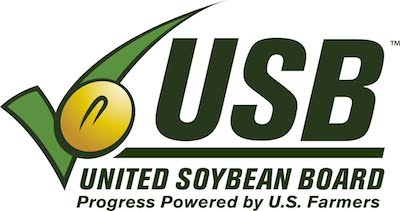 |
|
| |
| |
|
Welcome
Welcome to the May issue of the USAPEEC ASEAN Regional Office’s newsletter.
This newsletter seeks to provide readers with useful product and major market information for institutional and consumer users of U.S. poultry. Readers will find in every issue a variety of general market information, program activities as well as useful product information.
This month, we take a look at several market perspectives in the individual ASEAN countries.
Contents:
- U.S. Secretary of Agriculture met with U.S. co-operators and agribusinesses during Vietnam trip
- USAPEEC Pavilion is the center of attraction during Food & Hotel Asia 2016
- Vietnam is a rapidly growing market for U.S. agricultural exports
- Growing market for Halal foods in Singapore
-
How a good diet can help Singaporeans war against diabetes
|
|
|
| |
|
|
|
| |
|
Additional Market Information Available
We have updated our website to include more information on market reports and export documentation guidelines.
You can visit our ASEAN website at: www.usapeecasean.com |
|
|
| |
|
|
|
 |
|
U.S. Secretary of Agriculture met with U.S. co-operators and agribusinesses during Vietnam trip
Representatives from U.S. agribusinesses and trade associations based in ASEAN met with U.S. Secretary of Agriculture, Thomas Vilsack, during his trip to Vietnam on April 26. Insights on market development activities, market access issues and benefits of the TPP for their individual commodities were shared. Margaret Say, regional director of USA Poultry & Egg Export Council provided a brief summary on U.S. poultry program activities, prevailing barriers to trade in Vietnam and anticipated benefits from the TPP implementation.
Thomas Vilsack also met with Vietnamese Minister of Agriculture and Rural Development Cao Duc Phat during his Vietnam trip. They discussed the improvement in bilateral co-operation between the two countries, removal of trade barriers and the implementation of the TPP provisions. Vietnam is one of the fastest growing markets for U.S. agricultural products, with U.S. exports totalling to US$2.3 billion in 2015. Vietnam currently ranks 11th as the largest market for U.S. agricultural products comprising cotton, soybeans, processed products, dairy, poultry and eggs.
|
|
From left to right: Phil Karsting, Administrator FAS, USDA, Margaret Say, USAPEEC Regional Director and Thomas Vilsack, U.S. Secretary of Agriculture |
| |
|
|
|
|
|
USAPEEC Pavilion is the center of attraction during Food & Hotel Asia 2016
Thousands of trade visitors thronged the USA Poultry & Egg Export Council Pavilion at Food & Hotel Asia (FHA) 2016. FHA, Asia’s largest regional trade show, was held from April 12 to 15, 2016. FHA occupied 97,000 square meters of exhibition floor space. It attracted over 70,000 trade visitors from Asia Pacific, European Union, Australia, New Zealand, South America, Africa and the Middle East. Several scrumptious dishes were served for sampling by 12 U.S poultry exporters that were stationed at the USAPEEC Pavilion. Hard Rock Café chefs prepared chicken quesadillas, chicken tacos and chicken hot dogs for trade visitors to sample the different preparation methods using chicken. USAPEEC staff and U.S. poultry exporters received numerous trade inquires and several concrete orders for poultry products. The total sales volume generated was approximately over US$4.68 million. |
|
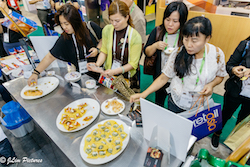 |
Trade visitors sampling poultry dishes at USAPEEC Pavilion at Food & Hotel Asia 2016 |
 |
Business discussion groups at USAPEEC Pavilion at Food & Hotel Asia 2016 |
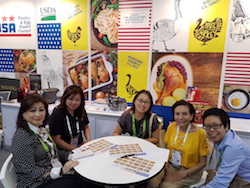 |
Margaret Say, USAPEEC, seated second from right, met with Indonesian trade associates. From left to right: Sherly Fam, PT Rezeki Inthi Artha, Sie Mei Ling, Angela Lijaya and Maya Djohari, PT Sukanda Djaya |
| |
|
|
|
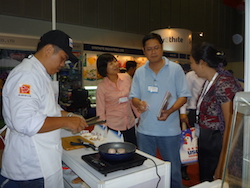 |
|
Vietnam is a rapidly growing market for U.S. agricultural exports
Vietnam is one of the fastest growing markets for U.S. agricultural products within the ASEAN region. U.S. exports of agricultural products in Vietnam increased by 70% from US$1.3 billion in 2010 to US$2.2 billion in 2015. Market opportunities for U.S. agricultural consumer products include poultry, beefs, tree nuts, dairy products, confectioneries, fresh fruits, seafood, wines, and non-alcoholic beverages. The ten largest U.S. agricultural products imported into Vietnam in 2015 are ranked in descending order below:
1) Cottons (US$622 million)
2) Tree nuts (US$274 million)
3) Soybeans (US$269 million)
4) Forest products (US$221 million)
5) Dairy products (US$168 million)
6) Distiller grains (US$155 million)
7) Soybean meals (US$137 million)
8) Fish products (US$115 million)
9) Poultries (US$82 million)
10) Animal feed (US$71 million)
|
|
Vietnamese trade associates attend Food & Hotel Asia 2016 to assess import prospects for new U.S. products |
| |
| |
|
|
|
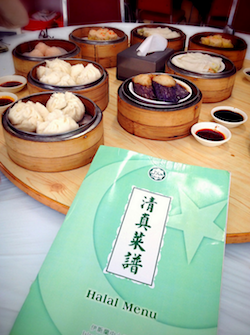 |
|
Growing market for Halal foods in Singapore
Halal means “permissible” or “lawful” for Muslims in Arabic. It refers to the preparation and consumption of a wide range of foods including chicken, beef, turkey, lamb and other non-meat products that strictly follow the Islamic law.
In Singapore, the Majlis Ugama Islam Singapore (MUIS), also known as the Islamic Religious Council of Singapore, has the sole authority to administer, regulate and issue Halal certificates. It is mandatory by law to obtain the Halal certificate before serving or selling Halal products in eateries and supermarkets in Singapore.
Valued at US$12 billion, Halal products form a highly competitive regional market in Southeast Asia. It caters to a large consumer market of over 250 million Muslims. A notable trend is the rise of Halal-certified cafes emerging in Southeast Asia, serving mains and desserts to cater to the Muslim population. These cafes also attract many non-Muslim patrons as well due to uniquely crafted menus and in-house specialties. MUIS has already certified approximately 2,900 premises in 2014.
In addition, a number of Chinese restaurants in Singapore have obtained Halal certificates to serve fried carrot cake, fried Chinese rice noodles, steamed rice cakes and much more to the Muslim customers. This is better known as dim sum, which is a Chinese-Cantonese cuisine that serves bite-sized food portions in small steamer baskets. By acquiring the Halal certificate, such restaurants can now cater to a wider variety of diners.
Although the Muslim population comprises only 15% of Singapore’s population of 5.5 million, a larger number of importers, retailers and restaurants find it more practical to distribute or retail Halal-certified foods. Restaurants have found that by ensuring their establishments are Halal-certified, their business volume has increased considerably. Fast food chains like McDonald’s, KFC, Burger King and a number of coffee chains have successfully obtain Halal certificates in Singapore.
Besides dining on Halal meat in Halal-certified eateries, customers can also purchase a diverse range of Halal poultry in major supermarkets to cook at home. With numerous Halal recipes widely available, it is simple to cook a scrumptious dish using Halal meat. Consumers can also replicate non-Halal dishes that they cannot sample using the Halal meat that they had purchased from supermarkets. Hainanese Chicken Rice, one of Singapore’s iconic national foods, involves a cooking process of poaching the chicken in pork broth. A Muslim individual will not be able to sample this dish since pork is strictly impermissible under Islamic law. By poaching the Halal chicken in chicken broth instead when attempting to replicate the Hainanese Chicken Rice, Muslims are now able to consume this traditional Chinese dish.
The burgeoning Halal food industry, paired with the presence of many Halal-certified eating establishments, has thus helped to better foster social interaction between customers from a myriad of racial, cultural and religious backgrounds.
|
|
Halal dim sums served in traditional Chinese restaurant
Credit: Amalia Sari |
| |
|
|
|
 |
|
How a good diet can help Singaporeans war against diabetes
Housing more than 400,000 diabetics in Singapore today, one in three is uncertain if they have diabetes. Among those who are diabetic, one in three underestimates their blood sugar levels. Upon clustering the aging population with obese young adults, it is estimated that one million will be diagnosed with diabetes by 2050.
Minister for Health Gan Kim Yong highlighted several areas in the multi-year plan to aid in the battle against diabetes. Encouraging the public to lead healthy lifestyles and going for early screenings or treatments are part of the pre-emptive measures that Ministry of Health (MOH) is currently undertaking. The toughest challenge to overcome is diet. Consuming unhealthy food and sugary drinks makes an individual more susceptible to obesity and diabetes. Therefore, by being well informed through health campaigns, the public can adopt a healthier diet to have a better quality of life.
Once the doctor has diagnosed a patient with diabetes, following a sugar-free diet is crucial to maintain the blood (glucose) sugar on a constant level. Excessive amounts of carbohydrates have been found guilty for increasing the blood glucose level. An ideal way in keeping diabetes under control is to adopt a healthy eating lifestyle through My Healthy Plate, a straightforward visual representation of a balanced and healthy meal by the Health Promotion Board (HPB) as displayed below.
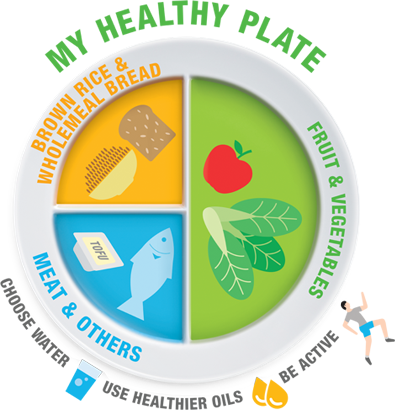
Credit: HPB
Other efforts to control diabetes include limiting the intake of sugary foods and drinks, monitoring weight regularly, consuming carbohydrate-rich foods in moderation and switching to fiber-rich starches like whole grains. These will help in maintaining the blood glucose level before and after meals.
Non-diabetics should also aim to sustain a balanced and healthy diet as well. According to HPB, the body absorbs dietary fiber, minerals and vitamins from whole grains, fruits and vegetables. Lean meats provide more protein than fatty ones. Proteins aid in building and repairing tissues in the body. Examples of lean meats are skinless chicken and turkey, egg whites, beef sirloin, fish and seafood. Skinless poultry provides lesser saturated fat and cholesterol. Meat consumption does not increase blood glucose level since there is no carbohydrate component in it. However, relying solely on the intake of proteins will not eradicate diabetes. Consumers are recommended to spend more time reading food labels to develop a better understanding of the contents before purchasing.
Diabetes and other chronic diseases can be circumvented by having consistent meals with moderate food intakes, accompanied with leading active lifestyle.
|
|
Sweet cakes served in a cafe
Credit: Andy Leung |
|
Disclaimer: All opinions and views expressed in the articles published in the newsletter are those of the individual journalists and do not necessarily reflect those of the publisher, the newsletter's sponsors or USA Poultry & Egg Export Council.
You have received this email because you have registered to get newsletters from USAPEEC ASEAN.
If you prefer not to receive these updates, please
click here
to unsubscribe.
Do not reply to this email. For enquiries, go to www.usapeecasean.com
® USA POULTRY & EGG EXPORT COUNCIL
541 Orchard Road, #15-04, Liat Towers, Singapore 238881 Tel: (65) 67371726 Fax: (65) 67371727
*|REWARDS|* |
|
|
|